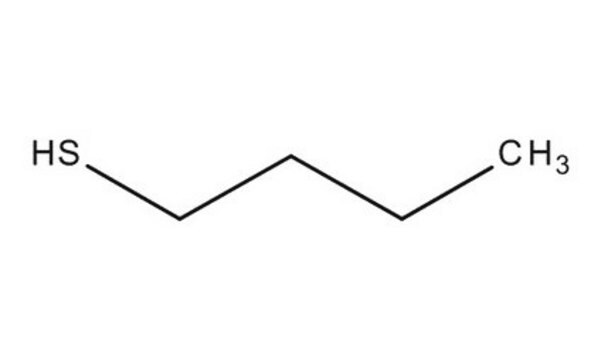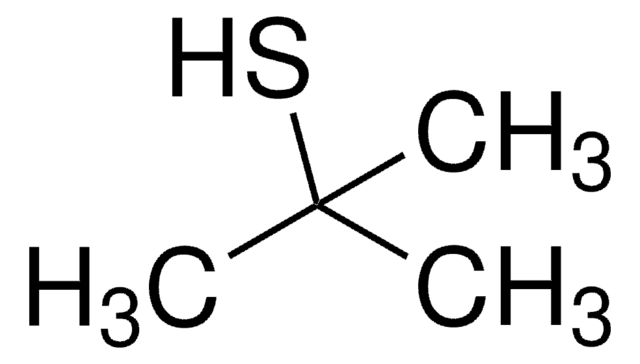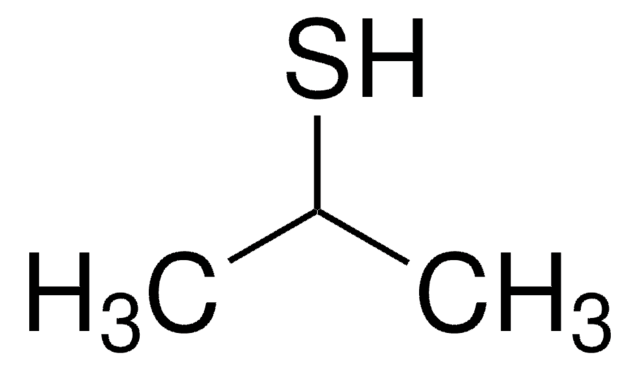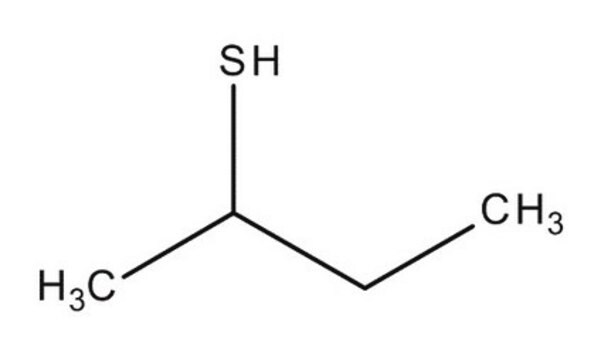Kluczowe dokumenty
112925
1-Butanethiol
99%
Synonim(y):
Butyl mercaptan, Mercaptan C4
About This Item
Polecane produkty
gęstość pary
3.1 (vs air)
Poziom jakości
ciśnienie pary
83 mmHg ( 37.7 °C)
Próba
99%
współczynnik refrakcji
n20/D 1.443 (lit.)
bp
98 °C (lit.)
mp
−116 °C (lit.)
gęstość
0.842 g/mL at 25 °C (lit.)
grupa funkcyjna
thiol
ciąg SMILES
CCCCS
InChI
1S/C4H10S/c1-2-3-4-5/h5H,2-4H2,1H3
Klucz InChI
WQAQPCDUOCURKW-UHFFFAOYSA-N
Szukasz podobnych produktów? Odwiedź Przewodnik dotyczący porównywania produktów
Powiązane kategorie
Zastosowanie
Hasło ostrzegawcze
Danger
Zwroty wskazujące rodzaj zagrożenia
Zwroty wskazujące środki ostrożności
Klasyfikacja zagrożeń
Acute Tox. 4 Inhalation - Acute Tox. 4 Oral - Eye Irrit. 2 - Flam. Liq. 2 - Skin Irrit. 2 - Skin Sens. 1 - STOT SE 3
Organy docelowe
Respiratory system
Kod klasy składowania
3 - Flammable liquids
Klasa zagrożenia wodnego (WGK)
WGK 3
Temperatura zapłonu (°F)
53.6 °F - closed cup
Temperatura zapłonu (°C)
12 °C - closed cup
Środki ochrony indywidualnej
Eyeshields, Faceshields, Gloves, type ABEK (EN14387) respirator filter
Wybierz jedną z najnowszych wersji:
Masz już ten produkt?
Dokumenty związane z niedawno zakupionymi produktami zostały zamieszczone w Bibliotece dokumentów.
Klienci oglądali również te produkty
Produkty
Self-assembled monolayers (SAMs) have attracted enormous interest for a wide variety of applications in micro- and nano-technology. In this article, we compare the benefits of three different classes of SAM systems (alkylthiolates on gold.
Global Trade Item Number
| SKU | GTIN |
|---|---|
| 1622000-125MG | 4061838746788 |
| 258768-100G | 4061835554812 |
| 258768-1KG | |
| 8.07680.1000 | |
| 8076800100 | 4022536397023 |
| 8076801000 | 4022536397030 |
| PHR1115-1G | 4061835233113 |
| S1350000 | 4061833815083 |
| S1350000-1EA | |
| S1350000-250MG | |
| 258768-1G | |
| 258768-5G | 4061826062265 |
| 8.07680.0100 | |
| 74723-1G | 4061826651926 |
| 74723-25G | |
| 74723-5G | 4061833354711 |
| O709-2KG | 4061832886145 |
| O709-1KG | 4061834248378 |
| 112925-1L | 4061838700520 |
| 112925-250ML | 4061838700537 |
Nasz zespół naukowców ma doświadczenie we wszystkich obszarach badań, w tym w naukach przyrodniczych, materiałoznawstwie, syntezie chemicznej, chromatografii, analityce i wielu innych dziedzinach.
Skontaktuj się z zespołem ds. pomocy technicznej











